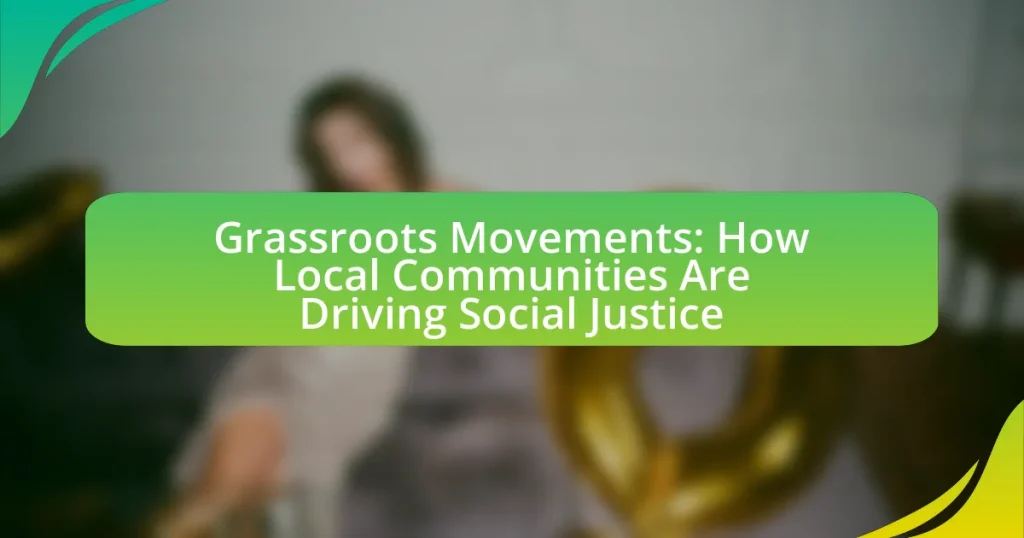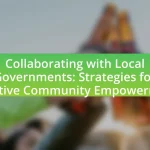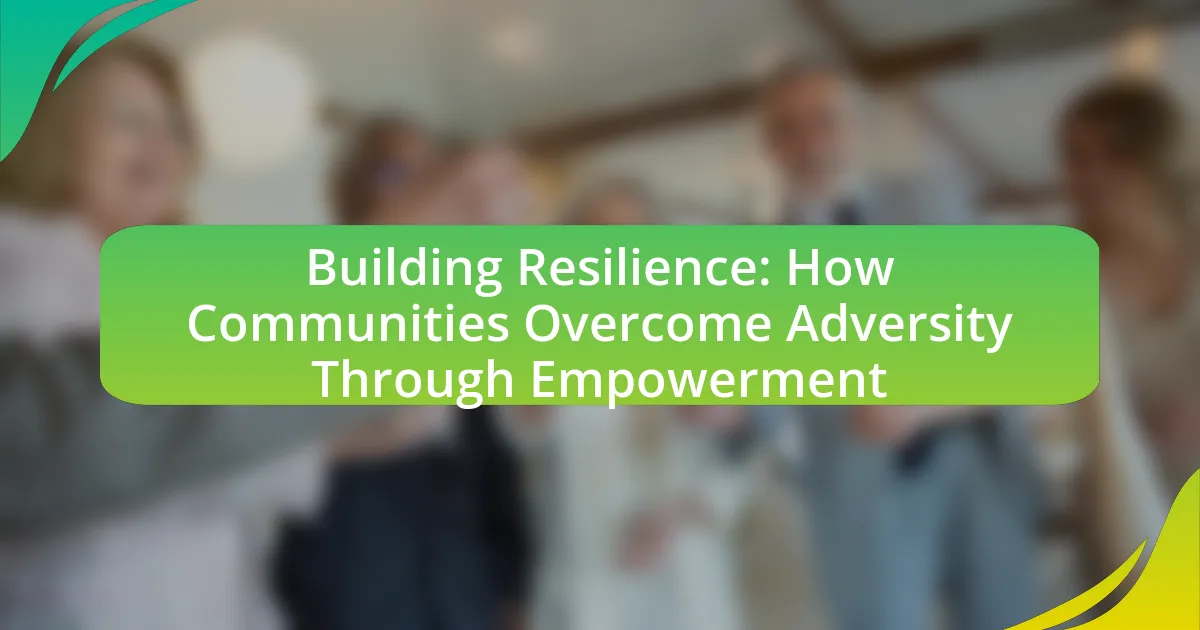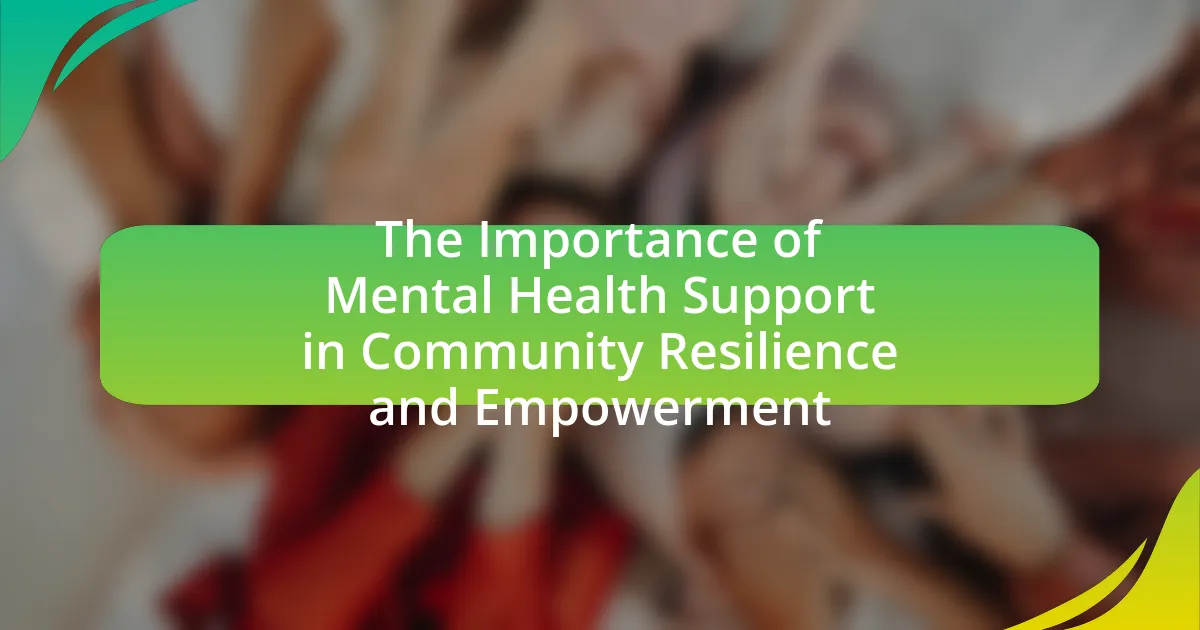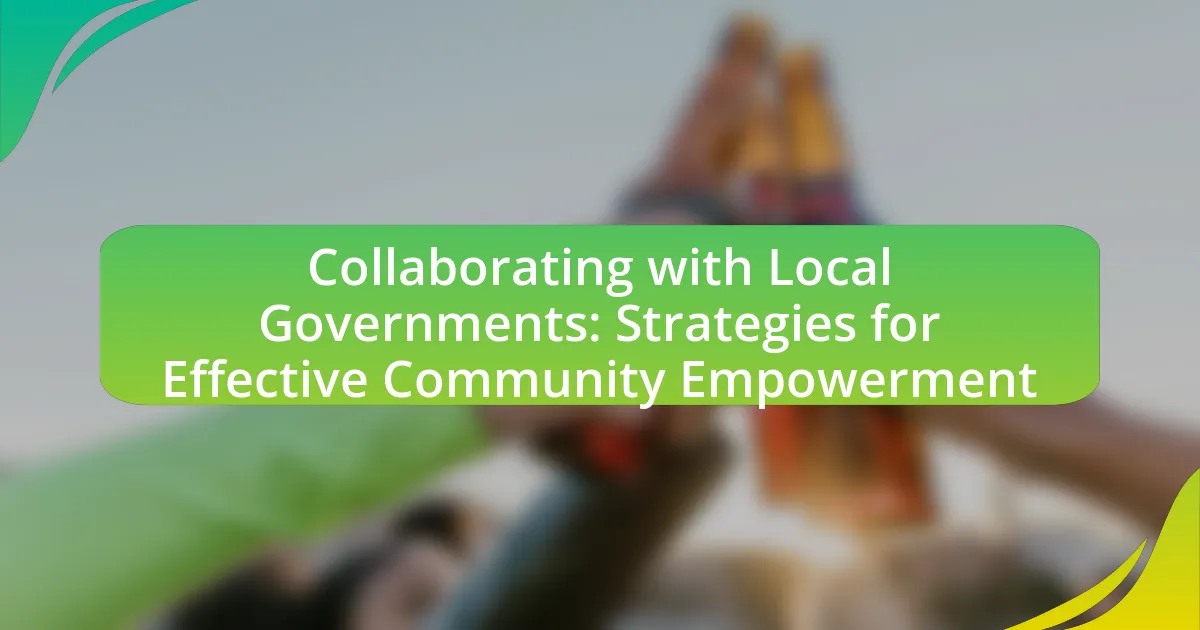Grassroots movements are collective efforts initiated by local communities to address social, political, or environmental issues through advocacy, education, and mobilization. This article explores the characteristics and significance of grassroots movements, highlighting their community-driven nature and decentralized structure, which differentiate them from traditional activism. It examines the role of local communities and leaders in mobilizing for social justice, the strategies employed to tackle various issues such as racial and economic inequality, and the challenges these movements face, including funding limitations and political opposition. Additionally, the article identifies best practices from successful grassroots movements and offers practical steps individuals can take to support these initiatives.
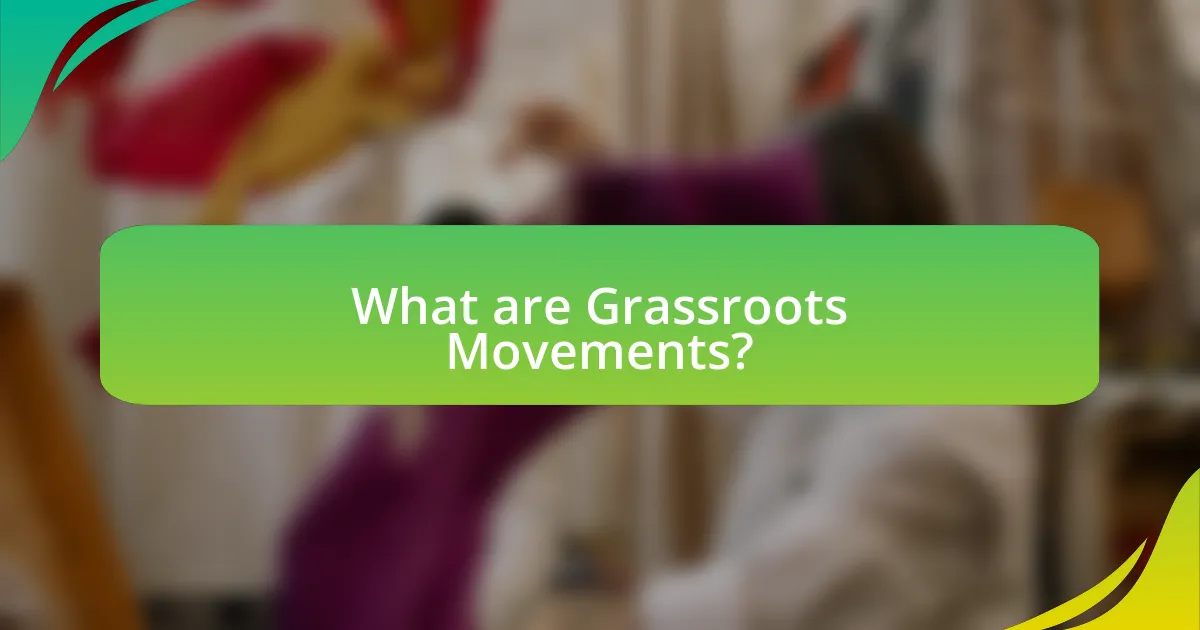
What are Grassroots Movements?
Grassroots movements are collective efforts initiated by local communities to address social, political, or environmental issues. These movements often emerge from the bottom up, relying on the active participation of individuals who share common concerns and seek to create change through advocacy, education, and mobilization. For instance, the Civil Rights Movement in the United States during the 1960s exemplifies a grassroots effort where local activists organized protests and campaigns to combat racial discrimination, leading to significant legislative changes such as the Civil Rights Act of 1964.
How do Grassroots Movements differ from traditional activism?
Grassroots movements differ from traditional activism primarily in their structure and approach, with grassroots movements being community-driven and decentralized, while traditional activism often relies on established organizations and top-down leadership. Grassroots movements mobilize local communities to address specific issues, fostering direct participation and collective action, as seen in movements like the Civil Rights Movement, which originated from local community efforts rather than centralized organizations. In contrast, traditional activism typically involves larger, formal organizations that may dictate strategies and campaigns, such as established NGOs or political parties. This distinction highlights the emphasis of grassroots movements on local engagement and empowerment, which can lead to more tailored and immediate responses to community needs.
What are the key characteristics of Grassroots Movements?
Grassroots movements are characterized by their community-driven nature, emphasizing local participation and collective action. These movements typically arise from the needs and concerns of ordinary people rather than top-down directives from established institutions. They often focus on social justice issues, mobilizing individuals to advocate for change through grassroots organizing, which includes community meetings, protests, and campaigns.
Additionally, grassroots movements rely on decentralized leadership, allowing for diverse voices and perspectives to shape their goals and strategies. This inclusivity fosters a sense of ownership among participants, enhancing engagement and commitment. Evidence of their effectiveness can be seen in historical examples such as the Civil Rights Movement in the United States, where local communities played a pivotal role in advocating for equality and justice.
Why are Grassroots Movements important for social change?
Grassroots movements are important for social change because they empower local communities to advocate for their rights and address issues directly affecting them. These movements often arise from the collective action of individuals who share common concerns, leading to increased awareness and mobilization around social justice issues. For instance, the Civil Rights Movement in the United States, which was largely driven by grassroots organizations, resulted in significant legislative changes, such as the Civil Rights Act of 1964. This demonstrates how grassroots efforts can lead to substantial societal transformation by fostering community engagement and influencing policy at higher levels.
What role do local communities play in Grassroots Movements?
Local communities serve as the foundational backbone of grassroots movements, providing essential support, mobilization, and local knowledge. They engage in organizing efforts, raise awareness about social issues, and foster a sense of collective identity among members. For instance, the Civil Rights Movement in the United States relied heavily on local community leaders and organizations to mobilize protests and advocate for change, demonstrating how grassroots efforts can effectively challenge systemic injustices. Additionally, studies show that grassroots movements led by local communities often achieve higher levels of participation and sustained engagement, as they resonate more deeply with the lived experiences and needs of those directly affected by social issues.
How do local leaders influence Grassroots Movements?
Local leaders significantly influence grassroots movements by mobilizing community members, providing resources, and shaping the narrative around social issues. They often serve as trusted figures who can galvanize support, articulate community needs, and foster a sense of collective identity. For instance, local leaders can organize meetings, facilitate discussions, and connect individuals to larger networks, thereby enhancing the movement’s visibility and impact. Research indicates that grassroots movements led by local leaders are more effective in achieving policy changes, as seen in the successful campaigns for civil rights and environmental justice, where local leadership played a crucial role in organizing efforts and rallying community support.
What strategies do communities use to mobilize for social justice?
Communities mobilize for social justice through strategies such as grassroots organizing, coalition building, advocacy, and public education. Grassroots organizing involves community members coming together to identify issues, develop action plans, and mobilize resources, as seen in movements like Black Lives Matter, which effectively utilized social media to raise awareness and coordinate protests. Coalition building allows diverse groups to unite around common goals, enhancing their collective power; for example, the Women’s March brought together various organizations advocating for women’s rights and social justice. Advocacy efforts often include lobbying local and national governments to enact policy changes, demonstrated by the successful push for the repeal of discriminatory laws in various states. Public education campaigns raise awareness about social justice issues, utilizing workshops, seminars, and social media to inform and engage the community, as evidenced by initiatives like the “Know Your Rights” campaigns that empower individuals with information about their legal rights.
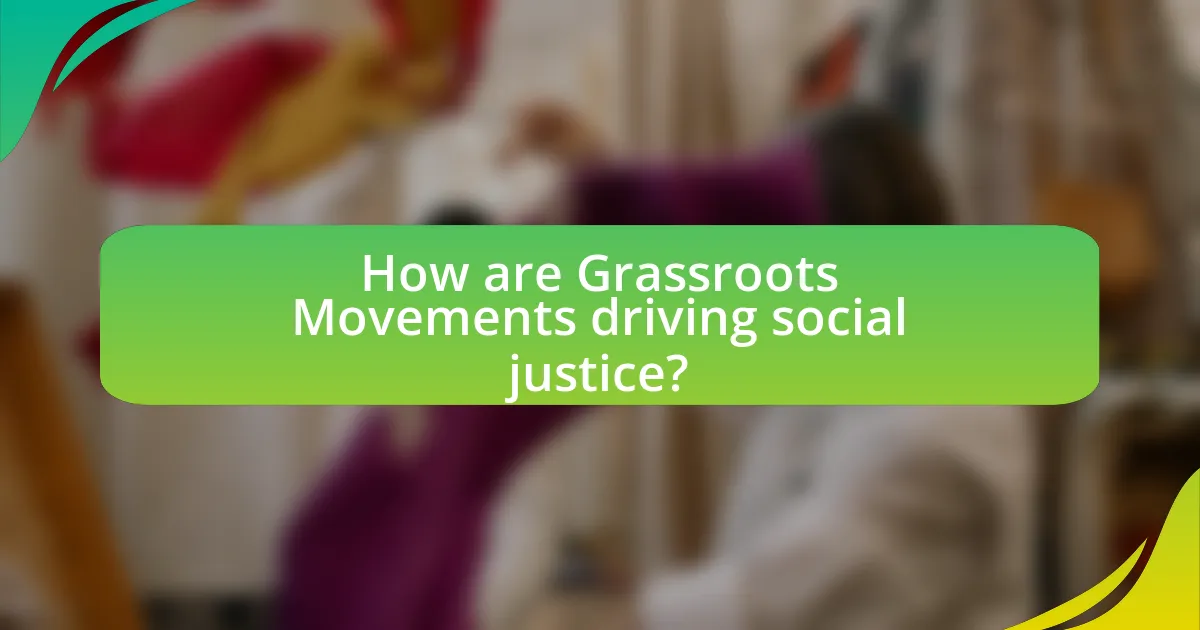
How are Grassroots Movements driving social justice?
Grassroots movements drive social justice by mobilizing local communities to advocate for systemic change and address inequalities. These movements empower individuals to organize, raise awareness, and influence policy decisions that affect their lives. For instance, the Black Lives Matter movement has effectively highlighted racial injustices and mobilized protests, leading to legislative discussions on police reform in various states. Additionally, grassroots organizations often utilize social media to amplify their messages, reaching wider audiences and fostering solidarity across different demographics. This combination of local engagement and broader outreach demonstrates the significant impact grassroots movements have on advancing social justice initiatives.
What specific social justice issues are addressed by Grassroots Movements?
Grassroots movements address specific social justice issues such as racial equality, economic justice, environmental justice, gender equality, and LGBTQ+ rights. These movements mobilize local communities to advocate for systemic change, often highlighting disparities in access to resources and opportunities. For instance, the Black Lives Matter movement focuses on combating systemic racism and police violence against Black individuals, while movements like Fight for $15 advocate for a living wage, emphasizing economic inequality. Additionally, environmental justice movements seek to address the disproportionate impact of environmental hazards on marginalized communities, demonstrating the interconnectedness of social justice issues.
How do Grassroots Movements tackle racial inequality?
Grassroots movements tackle racial inequality by mobilizing local communities to advocate for systemic change and raise awareness about injustices. These movements often employ strategies such as organizing protests, engaging in community education, and lobbying for policy reforms that address discriminatory practices. For instance, the Black Lives Matter movement has effectively highlighted police brutality and systemic racism, leading to legislative changes in various jurisdictions. Additionally, grassroots organizations often collaborate with marginalized communities to amplify their voices and ensure that their specific needs and experiences are represented in the fight against racial inequality.
What approaches do Grassroots Movements use to combat economic injustice?
Grassroots movements combat economic injustice through community organizing, advocacy, and direct action. These movements mobilize local populations to raise awareness about economic disparities, often focusing on issues such as wage theft, affordable housing, and access to resources. For instance, organizations like Fight for $15 have successfully advocated for minimum wage increases across various states, demonstrating the effectiveness of collective action. Additionally, grassroots movements often utilize social media to amplify their messages and connect with broader audiences, enhancing their impact and reach.
Why are Grassroots Movements effective in creating change?
Grassroots movements are effective in creating change because they mobilize local communities to advocate for their needs and interests directly. This localized approach fosters strong community engagement, allowing individuals to connect personally with the issues at hand. For example, the Civil Rights Movement in the United States demonstrated the power of grassroots organizing, where local leaders and community members worked together to challenge systemic racism and achieve significant legislative changes, such as the Civil Rights Act of 1964. Additionally, grassroots movements often utilize social media to amplify their message, reaching wider audiences and garnering support quickly, as seen in the global response to the Black Lives Matter movement. This combination of local action and broader outreach enables grassroots movements to effectively influence policy and societal norms.
What role does community engagement play in the success of Grassroots Movements?
Community engagement is crucial for the success of grassroots movements as it fosters collective action and mobilizes local support. When individuals within a community actively participate, they contribute to a shared vision and strengthen the movement’s legitimacy. For instance, the Civil Rights Movement in the United States gained momentum through community organizing, where local leaders engaged residents to advocate for social change, resulting in significant legislative achievements like the Civil Rights Act of 1964. This historical example illustrates that effective community engagement not only amplifies voices but also creates a sense of ownership and accountability, essential for sustaining grassroots efforts.
How do Grassroots Movements leverage social media for advocacy?
Grassroots movements leverage social media for advocacy by utilizing platforms to mobilize supporters, disseminate information, and amplify their messages. These movements create online campaigns that engage users through hashtags, shareable content, and targeted messaging, which can rapidly spread awareness and foster community involvement. For instance, the #BlackLivesMatter movement effectively used Twitter and Instagram to organize protests and share real-time updates, resulting in widespread global participation and increased visibility for social justice issues. This strategic use of social media not only enhances outreach but also facilitates direct communication between activists and the public, thereby strengthening community ties and advocacy efforts.
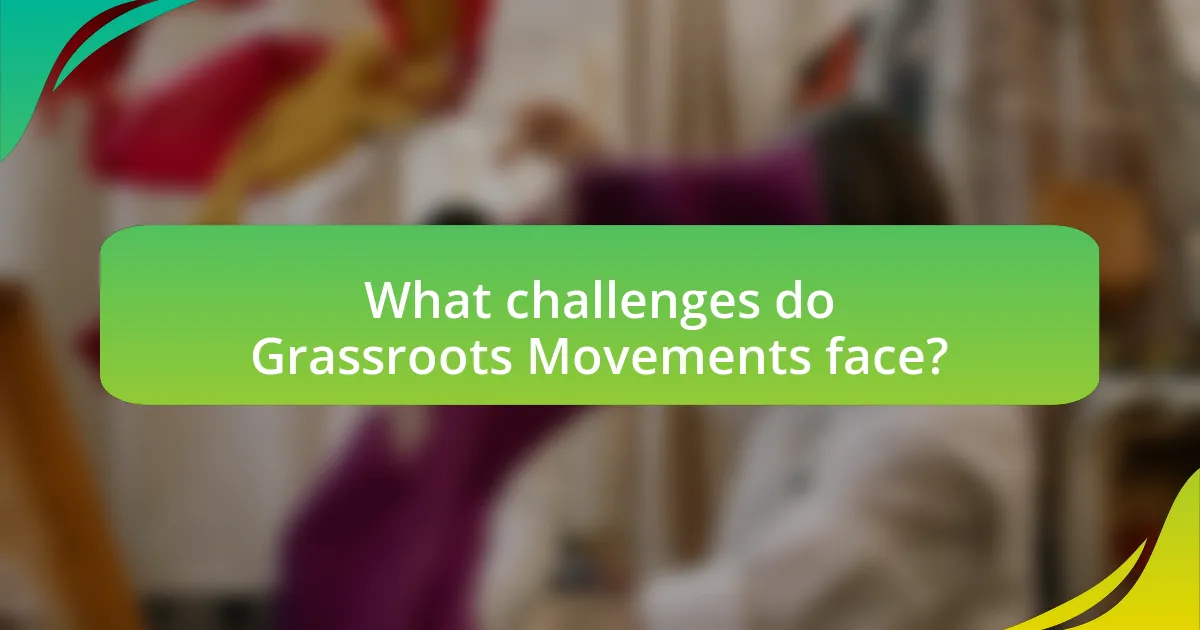
What challenges do Grassroots Movements face?
Grassroots movements face several significant challenges, including limited funding, lack of media attention, and internal conflicts. Limited funding restricts their ability to organize events, mobilize supporters, and sustain long-term initiatives, as many rely on small donations or volunteer efforts rather than substantial financial backing. Lack of media attention often leads to insufficient public awareness and support, making it difficult for these movements to gain traction and influence policy changes. Internal conflicts can arise from differing priorities or strategies among members, which can hinder decision-making and weaken the overall effectiveness of the movement. These challenges collectively impede the ability of grassroots movements to achieve their social justice goals.
How do funding and resources impact Grassroots Movements?
Funding and resources significantly impact grassroots movements by determining their operational capacity and outreach effectiveness. Adequate financial support enables these movements to organize events, mobilize volunteers, and engage in advocacy efforts, which are crucial for raising awareness and influencing policy changes. For instance, the Black Lives Matter movement has utilized donations to fund protests, educational campaigns, and community programs, demonstrating how financial resources can amplify a movement’s voice and reach. Additionally, access to resources such as technology and communication tools enhances grassroots movements’ ability to connect with broader audiences, facilitating rapid information dissemination and community engagement.
What are the common obstacles to sustaining Grassroots Movements?
Common obstacles to sustaining grassroots movements include lack of funding, insufficient leadership, and burnout among volunteers. Funding challenges often arise due to limited access to financial resources, which can hinder the ability to organize events or campaigns effectively. Insufficient leadership can lead to disorganization and a lack of direction, making it difficult for movements to maintain momentum. Additionally, volunteer burnout occurs when individuals become overwhelmed by the demands of activism, resulting in decreased participation and engagement. These factors collectively impede the long-term viability of grassroots movements, as evidenced by numerous case studies highlighting the decline of initiatives that faced these challenges.
How do Grassroots Movements navigate political opposition?
Grassroots movements navigate political opposition by employing strategic coalition-building, grassroots mobilization, and effective communication. These movements often form alliances with other organizations and community groups to amplify their voices and increase their influence, as seen in the Civil Rights Movement, where coalitions were crucial for overcoming systemic resistance. Additionally, grassroots mobilization involves organizing community members to participate in protests, advocacy, and lobbying efforts, which can pressure political entities to respond to their demands. Effective communication, including the use of social media, allows these movements to disseminate their messages widely, counter misinformation, and rally support, exemplified by the #MeToo movement’s ability to raise awareness and challenge political figures.
What can be learned from successful Grassroots Movements?
Successful grassroots movements demonstrate the power of community organization and collective action in driving social change. These movements often highlight the importance of local engagement, as seen in the Civil Rights Movement, where grassroots efforts mobilized communities to challenge systemic racism and led to significant legislative changes like the Civil Rights Act of 1964. Additionally, successful grassroots movements teach the value of adaptability and resilience, as they often face opposition and must pivot strategies to maintain momentum. The Women’s March in 2017 exemplifies this, as it united diverse groups to advocate for women’s rights and social justice, showcasing the effectiveness of inclusive coalitions. Furthermore, these movements reveal the significance of storytelling and personal narratives in galvanizing support and raising awareness, as evidenced by the #MeToo movement, which empowered individuals to share their experiences and fostered a global dialogue on sexual harassment and assault.
What best practices can be identified from effective Grassroots Movements?
Effective grassroots movements utilize several best practices, including community engagement, clear messaging, and coalition building. Community engagement fosters trust and mobilizes local support, as seen in the Civil Rights Movement, where grassroots organizations like the Student Nonviolent Coordinating Committee (SNCC) engaged directly with communities to drive participation. Clear messaging ensures that the movement’s goals resonate with a broader audience, exemplified by the Women’s March, which effectively communicated its objectives through inclusive and relatable language. Coalition building enhances the movement’s reach and impact, as demonstrated by the collaboration between various social justice organizations during the Black Lives Matter protests, which united diverse groups under a common cause. These practices collectively contribute to the effectiveness and sustainability of grassroots movements in driving social justice.
How can new Grassroots Movements apply these lessons?
New grassroots movements can apply lessons from previous successful initiatives by focusing on community engagement, strategic messaging, and coalition-building. For instance, movements like Black Lives Matter have demonstrated the importance of grassroots organizing and leveraging social media to amplify their message, which can be emulated by new movements to increase visibility and support. Additionally, historical examples such as the Civil Rights Movement show that sustained advocacy and collaboration with diverse groups can lead to significant policy changes, providing a framework for new movements to follow. By analyzing these successful strategies, new grassroots movements can effectively mobilize resources and foster community solidarity to drive social justice initiatives.
What practical steps can individuals take to support Grassroots Movements?
Individuals can support grassroots movements by actively participating in local initiatives, volunteering time, and donating resources. Engaging in community events, such as town hall meetings or rallies, allows individuals to amplify the voices of grassroots organizations. Volunteering for these movements provides essential manpower and skills, which are often in short supply. Financial contributions, no matter how small, can significantly impact the sustainability of grassroots efforts, as many rely on donations to fund their activities. Research shows that grassroots movements, like the Black Lives Matter movement, have gained momentum through community involvement and support, demonstrating the effectiveness of individual contributions in driving social justice.
